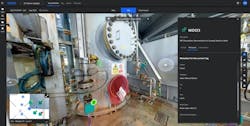ADIPEC 2023: James Fisher AIS digital twins reduce downtime
By Ariana Hurtado, Editor and Director of Special Reports
James Fisher Asset Information Services' (AIS) R2S digital twin software is an asset management technology that presents any 2D data, visual data and real-time data in a real-world context to help users with planning and decision-making. The software connects site imagery to the user's existing data and systems to provide a visually immersive information experience, the company explained.
Ramping up for the ADIPEC 2023 event this week, Offshore chatted with Adeshina Adebusuyi, business development manager with James Fisher AIS, about the digital twin technology, its capabilities and applications, and the digital market.
James Fisher AIS is exhibiting at booth 15013 in Hall 15 and showcasing the latest version of R2S.
Digital disillusionment
Adebusuyi explained a concept the company refers to as "digital disillusionment," which means users have invested in technologies that did not solve their issues and are thus skeptical of investing in other technologies.
"The digital market is growing rapidly," he said. "There are hundreds of new offerings every day, and with tools like generative AI, we’ll absolutely see many more coming through. But the challenge for operators is to find those tools that can actually deliver on their promises, providing real value and avoiding further digital disillusionment."
He continued, "Various technologies have fallen short in meeting user needs due to existing processes adaptability constraint, scalability issues, poor user experiences, innovation stagnation and high costs. For the end client, we regularly hear such stories that culminate in a term we call ‘digital disillusionment,' leaving operators dissatisfied in their investment and wary of other technologies. These shortcomings have created opportunities for proven solutions like R2S to deliver real value and provide actionable insights that drive efficiencies for offshore energy companies."
Developing the digital twin technology
R2S was developed more than 12 years ago in Aberdeen specifically for crime scene investigations, in which investigators and trial juries required a detailed replica of the scene.
However, the industry-crossover potential proved beneficial.
"North Sea oil and gas operators rapidly saw the core advantages of the technology to save time, save money, enhance collaboration and improve safety," Adebusuyi said. "And in the preceding years, R2S has been developed with user feedback at its core. Last year, the latest version saw the application re-engineered from the ground up into a browser-based application enabling rapid deployment and fast updates."
Case study
James Fisher AIS released case study details in late August about a Gulf of Mexico (GoM) operator utilizing the R2S software to overcome limited bed space and enhance collaboration between onshore and offshore teams. The application generated a real-world walk-around experience of any facility, using high-resolution 360-degree images and embedded asset data to create a one-stop data repository, the company stated.
The digital representation featured tagged equipment linked to existing documents and databases, granting users access to maintenance records, a spare parts database and other relevant documentation via direct plug-ins linked into existing systems.
Compared to traveling to visualize the asset(s) in person, R2S created a virtual environment that allowed the team to remain onshore while providing value offshore.
To read more of Offshore's conversation with Adebusuyi, check out the Q&A below.
OFFSHORE: What is the offshore energy sector's need for the R2S digital twin technology?
ADEBUSUYI: Using digital twins in offshore energy operations provides asset owners with the opportunity to react quickly to potential faults. This helps to reduce downtime, maximize output and ultimately increase operational efficiency.
Not to mention that in a rapidly scaling industry, safety is paramount and digital twins have the added benefit of optimizing safety measures. By facilitating informed decisions, digital twins give operators peace of mind as they can help to prevent both asset and human damage.
R2S digital twin technology involves creating a digital replica of an asset while continuously enriching and sustaining it with real-time data. There are several reasons the offshore energy sector is increasingly interested in adopting R2S digital twin technology, which includes predictive maintenance, asset monitoring and management, improved safety, energy optimization and data-driven decision-making, just to mention a few.
OFFSHORE: What are the tool's capabilities and offshore applications?
ADEBUSUYI: R2S provides powerful digital capabilities to owners of complex assets as their teams’ transition to new ways of working. Our application is enabling teams to visually plan and deliver work more effectively.
The R2S digital twin application provides a digital workspace enabling teams to understand the visual context of an asset for the preparation, planning and execution of projects.
R2S manages any type of reality capture data (drone, laser scan, 360 imagery) to maintain an up-to-date reality model of the asset. That’s the baseline for R2S. Beyond that is where we layer different data types onto the asset visualization. Engineering data which R2S seamlessly connects to such as equipment registers, P&IDs, data sheets. Our final layer is project data. It’s here that we provide tremendous value for planners by integrating any type of project data into the digital twin in locational context.
OFFSHORE: How can companies facilitate access to energy by improving operations through digitalization, ensuring regional and global energy security?
ADEBUSUYI: Companies can facilitate access to energy and contribute to regional and global energy security by leveraging digitalization to improve their operations in energy storage solutions, renewable energy integration, smart grids, remote monitoring and control, cybersecurity measures and global connectivity.
All of these things contribute to the democratization of energy supply and access. Digital tools enable the faster building of new energy facilities in some of the most remote parts of the world, it extends asset lifespan on brownfield sites by reducing outages through monitoring, as well as supporting better planning and execution of work to ensure that during a shutdown period the pre-planning is much tighter, resulting in fewer unexpected issues.
OFFSHORE: What's the path forward for the offshore energy sector?
ADEBUSUYI: Technology advancement, environmental concerns and market dynamics are key factors in deciding the path forward for the offshore energy sector. It’s clear that the sector will continue to evolve toward cleaner and more sustainable energy sources, and digital solutions will be key to staying one step ahead of the challenges associated with offshore operations.
10.02.2023
About the Author
Ariana Hurtado
Editor-in-Chief
With more than a decade of copy editing, project management and journalism experience, Ariana Hurtado is a seasoned managing editor born and raised in the energy capital of the world—Houston, Texas. She currently serves as editor-in-chief of Offshore, overseeing the editorial team, its content and the brand's growth from a digital perspective.
Utilizing her editorial expertise, she manages digital media for the Offshore team. She also helps create and oversee new special industry reports and revolutionizes existing supplements, while also contributing content to Offshore's magazine, newsletters and website as a copy editor and writer.
Prior to her current role, she served as Offshore's editor and director of special reports from April 2022 to December 2024. Before joining Offshore, she served as senior managing editor of publications with Hart Energy. Prior to her nearly nine years with Hart, she worked on the copy desk as a news editor at the Houston Chronicle.
She graduated magna cum laude with a bachelor's degree in journalism from the University of Houston.


